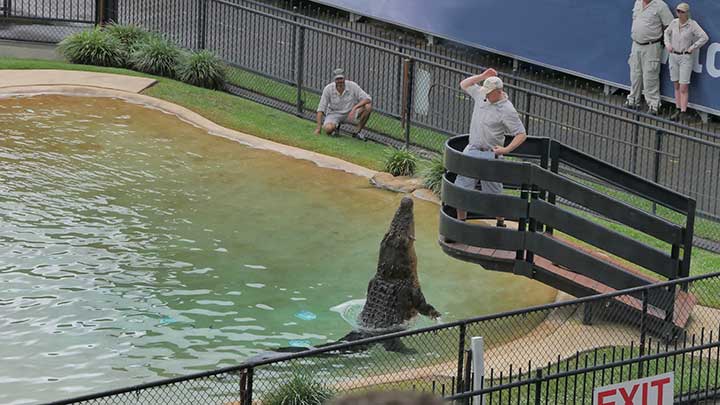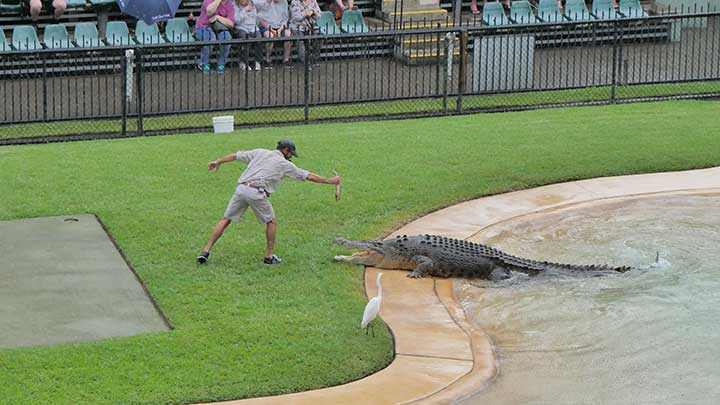Alligators and crocodiles both live in Florida. Crocodiles live in both saltwater and freshwater while alligators live in freshwater. There are an estimated 1.25 million alligators that live in Florida. That is way more than the estimated 2,000 crocodiles that live in south Florida. Most of these crocodiles live in the everglades or in the Florida Keys.

American crocodiles came off the endangered species list in 2007 but they are still very much protected. Their numbers are growing in Florida and sightings are becoming more and more common in the Florida Keys. Many people are unaware that crocodiles live in Florida. There has only been one attack by a crocodile in Florida. In this incident, a man and woman were both bitten while swimming in a canal in a residential neighborhood south of Miami. The attack was not fatal. In most cases, people and crocodiles keep their distance. Below we will look at times where crocodiles were filmed in the Florida Keys.
Crocodiles in Florida
1. Islamorada Florida Crocodiles
Islamorada is about 72 miles east of key west and about 80 miles from Miami. This places the key just south of the everglades. Islamorada is known as the fishing capital of the world and also has some crocodiles. Sighting of crocodiles in this key is not very common. However, in certain areas where they nest, they are commonly seen each year in Islamorada. Crocodiles are more common just a bit further north in the everglades.
The number one killer of crocodiles is getting killed in vehicle traffic. For this reason, it is important to drive at a reasonable speed and keep your eyes out for crocodiles that might be crossing the road. In the video below a crocodile is swimming in the mangroves while people are kayaking in the area. The crocodile does not seem to be bothered much by the people being in the area.
2. Marathon Florida Crocodiles
Marathon is in the Florida Keys and is about 30 miles southwest of Islamorada. Crocodile sightings are less common in Marathon than in the upper keys and everglades. In the video below a crocodile is spotted resting on a power cord and hose at the Boot Key Harbor in Marathon. It looks like the crocodile is interested in fish near an underwater light. The crocodile is about 8 feet in length.
3. Crocodiles in Key West
There are even crocodiles are far south as Key West Florida. Further actually, even all the way to the Dry Tortugas which is about 70 miles west of Key West. This shows that crocodiles can travel across the open ocean. The video below shows great footage of a crocodile filmed by a snorkeler. There are lots of minnow and baitfish swimming around and the water is crystal clear.
This particular crocodile was well known in the area and was named Cleatus. It was living in the area for over 14 years without incident. The national park service relocated the crocodile in 2017 to the everglades national park. The park service evidently thought the crocodile was approaching people that had food. The Dry Tortugas National Park does get a lot of visitors that come to snorkel and swim in the area.
The video below shows the crocodile being captured for relocation. It gets a private seaplane ride to its new home!
4. Crocodile Eats Stingray
The diet of the American crocodile consists of fish such as tarpon, bass, mullet, silversides, pilchards, snapper, and stingrays. These crocodiles also eat mammals and birds such as opossums, rabbits, raccoons, goats, hogs, cows, herons, pelicans, and similar species. Other things they eat include frogs, crabs, insects, and turtles.
I took the video below while kayaking in the Florida Keys. It was around 10:00 at night at my nephew and I were out looking for spiny lobster. We also see lots of other cool things like blacktip sharks, nurse sharks, stingrays, tarpon, barracuda, and ballyhoo jumping out of the water.
We see a very large stingray go by which we thought was cool. Then as it goes into water that is about two feet deep their is a loud splashing noise and the stingray starts getting spun around in circles. As time goes on the stingray gets spun faster in what appears to be a crocodile roll. A tail is seen coming out of the water but it is hard to see the crocodile as it is nighttime.
Do not Feed Crocodiles

It is important not to feed crocodiles if you see them. After catching fish is it common to throw fish scraps into the water. In areas where fish are caught daily sharks, tarpon, snappers, and jacks tend to live there waiting to be feed. This would not be a good thing for crocodiles.
If they get used to associating humans with food the crocodiles will likely be seen as a problem for many people. It is better for crocodiles to be scared of humans and not learn to approach them. This helps protect small children, swimmers, and pets that spend time in shallow water and along the edge of the water. There are stiff fines in Florida for feeding wild crocodiles or alligators.
Crocodiles and Alligators in Florida
There are an estimated 1.25 million alligators in Florida and only 2,000 crocodiles. This means there are 625 alligators for every one crocodile. Some of their territory overlaps and crocodiles can eat alligators or other crocodiles. The main way to tell the difference between crocodiles and alligators is that crocodiles have a more narrow snout. Crocodiles also have large teeth on both the top and bottom jaw shown when their jaws are closed. This makes crocodiles have a very toothy appearance. For alligators, the teeth along the upper jaw are shown the mouth is closed.
Captain Cody has worked on charter fishing boats in the Florida Keys, Virgin Islands, and Alaska. Growing up in Pennsylvania Cody has also done extensive freshwater fishing including bass fishing tournaments. Cody strives to provide detailed information about the best fishing gear and tactics to help both novice and experienced anglers have a more productive and enjoyable time on the water. Cody also has a background in aerospace engineering and neuroscience but really only takes pride in being good at one thing and that is fishing!
